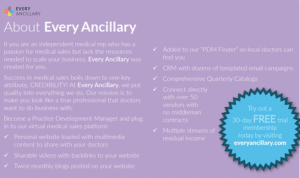As a medical sales professional, you often spend weeks or months prospecting new clients in the hopes of getting a short window of their undivided attention. The last thing you want to do is blow the opportunity you worked so hard for.
Since there is a lot of information that you have crammed into your brain, the temptation is to regurgitate everything you know, getting in as many points as possible during your short meeting. However, this rarely has the desired effect.
Why doesn’t this work?
The simple fact of the matter is that doctors do not trust your motives when you do most of the talking. Unfortunately, many medical sales professionals have not learned this lesson, and physicians are finding less value in sales reps, increasingly relying on doing their own research to learn about products and services. Consequently, research has shown that nearly half of HCPs can envision a world with NO SALES REPS!
Go against your intuition
Buying is an emotional decision, so you want to create the right emotional state. When you dominate the conversation or speak too rapidly, it conveys nervousness on your part, which creates an emotional state of uncertainty. An uncertain mind always says “no.”
Conversely, in the book Be Quiet, Be Heard, the authors show that people who speak more than 51% of the time during a conversation tend to be more satisfied with the conversation.
Your goal as a medical sales professional should be to keep a 2/3 : 1/3 ratio in your conversations with HCPs. Every moment you are listening to your customer, you are acquiring clues as to best tailor your approach moving forward.
By slowing down your pace and not dominating the conversation, you exude confidence, which is the proper emotion to influence behaviour.
Here are 6 practical tips that any medical sales professional can employ to improve your conversation ratio.
1 – Plan Ahead
Pre-call planning is a huge factor in your success as a medical sales rep because it allows you to plan ahead with some open-ended questions that are pertinent to your audience, opening up a dialogue.
Do your research and find out as much as you can about your prospects ahead of time. Prospects feel you are more knowledgeable when you ask good questions and tend to grant you more time.
Have several open-ended questions ready. For example, ”What challenges have you faced treating patients with condition x?”
Then you can encourage your prospect to expand on their answer. ”Can you tell me more?” “How does this impact your practice?”
2 – Pique Their Curiosity with Interesting Story
One of the best ways to pique someone’s interest is to share a real-life example of someone else who benefited. Ideally, you want the prospect to put themselves in this person’s shoes.
Therefore, the best examples will be someone with the same position, facing the same challenges and trying to achieve similar objectives. Make this person the hero of your story, choosing to work with your company to achieve their desired results.
By doing this, your prospect will likely become more engaged, sharing more with you about their own challenges.
3 – Pause
Since most interactions in medical sales are short, it can be stressful feeling like you have to have the right answers quickly.
In a stressful situation, you are almost always better off taking a pause and slowing down. Otherwise, you may come across as frantic and out of control.
Time feels faster when you are stressed. Most people rush and only give themselves 30% of the time they would give someone else to respond.
By pausing and contemplating what you are going to say, you are exuding confidence, which is exactly what you want to emote.
4 – Restate what they say
One mistake that can derail a sales call is when you misinterpret the prospect’s message. This can result in back peddling, bringing up points that do not connect with what they shared with you.
To curtail this, be sure to take the time to listen carefully, fully comprehend, ask clarifying questions, then restate the prospect’s point back to them to be sure you are on the same page.
This form of active listening will show your prospect they are being heard, which will build trust and make them share more.
5 – Focus on 1 Solution at a Time
The product that you are selling may have several key benefits for your prospect that you want to convey to them. After all, more benefits are better, right?
However, this can cause you to dominate the conversation and often oversell your product.
If your goal is to get your prospect to do most of the talking, then a good strategy is to pick out the most salient feature that will connect with their pain points and focus on asking open-ended questions around that.
For example, “This treatment has shown in recent studies to reduce LDL cholesterol by x%…how would your patients with hyperlipidemia benefit from that? Where would you see yourself using this in your practice?”
6 – Clarify Next Steps
The conclusion of your sales presentation can also present an opportunity to let your prospect do more of the talking, not to mention it can help you qualify how likely they are to work with you.
On average, it takes 5-9 calls to close a sale in the medical sector, so it is unrealistic to think you will walk out with a sale on your first visit.
A good question to ask would be…”How do you evaluate bringing on new products or services?”
To qualify how warm your lead is, you can ask…”How serious are you about meeting these objectives?”
This creates an additional opportunity to get the prospect to speak more, plus it will give you a roadmap so you can develop a targeted strategy moving forward.


